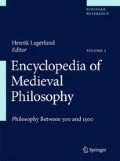Abstract
Byzantine aesthetics comprises views on traditional aesthetic concepts (beauty, light) and problems (values and properties) as well as discussions relevant to art theory (the status of the work of art, the functions of art, the beholder). It does not form a coherent system and it has to be reconstructed through numerous texts of different genres (philosophical, theological, rhetorical, etc.). The sources of Byzantine aesthetics, concerning mainly the visual arts, are ancient Greek aesthetics (late Platonic tradition on and rhetorical descriptions of works of art) and early Patristic thought (presenting the Christian attitude toward art and an elaborated theory of beauty). Art is appreciated, but in so far as it is a human creation that appeals to the senses it could be justified only on metaphysical grounds. The Byzantines’ major contribution was the theory of image that was elaborated during Iconoclasm (eighth to ninth century) and legitimated in theological and philosophical terms orthodox religious art.
Bibliography
Primary Sources
(1960) Acts of the seventh Ecumenical council: Sacrorum Conciliorum nova et amplissima collectio, ed. Mansi JD, vols 12, 13. Akademische Druck- u. Verlagsanstalt, Graz, pp 951–1154, 1–758
Brubaker Leslie, Haldon John (2001) Byzantium in the iconoclastic era (ca. 680–850): the sources. Ashgate, Aldershot
Damascene John (1975) Apologetic orations against the calumniators of the Holy Icons, ed. Kotter B. Die Schriften des Johannes von Damaskos, vol 3 (Patristiche Texte und Studien 17). Gruyter, Berlin. English edition: Damascene John (2003) Three treatises on the divine images, trans. Louth A. St. Vladimir’s Seminary Press, Crestwood
Mango Cyril (1986) The art of the Byzantine empire, 312–1453: sources and documents. Medieval Academy of America, Toronto
Nikephoros (1989) Refutation and rejection of the nonsense against the redemptive incarnation of God the word: Patrologia Graeca. In: Nicéphore, Discours contre les iconoclasts, trans. Mondzain-Baudinet M-J, vol 100. Klincksieck, Paris, pp 205–533
Nikephoros (1997) Critical examination and rejection of the false definition of the Apostates who refuse the redemptive economy of the divine word. In: Featherstone JM (ed) Nicephori Patriarchae Constantinopolitani Refutatio et Eversio Definitionis Synodalis Anni 815 [CCSG 33]. Brepols, Turnhout
Photius (1959) Homilies: Photiou Homiliai. Thessaloniki, ed. Laourdas B. English edition: Photius (1958) The homilies of Photius, Patriarch of Constantinople, trans. Mango C. Dumbarton Oaks, Cambridge
Procopius of Gaza (1939) Description of an image, ed. and trans. Friedländer P. Spätantiker Gemäldezyklus in Gaza: Des Prokopios von Gaza’′κφρασις Εἰκόνος. Biblioteca Apostolica Vaticana, City of Vatican
Theodore of Stoudite (1981) Refuting discourses against iconoclasts (PG 99), trans. Roth C. St Theodore the Stoudite on the Holy Icons. St. Vladimir’s Seminary, Crestwood, pp 327–436
Thümmel Hans Georg (1992) Die Frühgeschichte der Ostkirchlichen Bilderlehre: Texte und Untersuchungen zur Zeit vor dem Bilderstreit. Akademie, Berlin
Secondary Sources
Byčkov V (1983) L’estetica bizantina. Congedo, Bari
Hunger H (1978) Die hochsprachliche profane Literatur der Byzantiner, vol 1. Beck, München, pp 170–188
James L (1996) Light and colour in Byzantine art. Oxford University Press, Oxford
Kitzinger E (1954) The cult of images in the age before iconoclasm. Dumbart. Oaks Papers 8:83–150.
Maguire H (1981) Art and eloquence in Byzantium. Princeton University Press, Princeton
Maguire H (1999) The profane aesthetic in Byzantine art and literature. Dumbart. Oaks Papers 53:189–205.
Maguire ED, Maguire H (2007) Other icons: art and power in Byzantine secular culture. Princeton University Press, Princeton
Mathew G (1963) Byzantine aesthetics. Murray, London
Michelis P (1955) An aesthetic approach to Byzantine art. Batsford, London
Ouspensky L (1992) Theology of the icon. St. Vladimir’s Seminary Press, Crestwood
Pelikan J (1989) Imago Dei: the Byzantine apologia for icons. Yale University Press, Yale
Author information
Authors and Affiliations
Editor information
Editors and Affiliations
Rights and permissions
Copyright information
© 2011 Springer Science+Business Media B.V.
About this entry
Cite this entry
Zografidis, G. (2011). Aesthetics, Byzantine. In: Lagerlund, H. (eds) Encyclopedia of Medieval Philosophy. Springer, Dordrecht. https://doi.org/10.1007/978-1-4020-9729-4_14
Download citation
DOI: https://doi.org/10.1007/978-1-4020-9729-4_14
Publisher Name: Springer, Dordrecht
Print ISBN: 978-1-4020-9728-7
Online ISBN: 978-1-4020-9729-4
eBook Packages: Humanities, Social Sciences and Law

